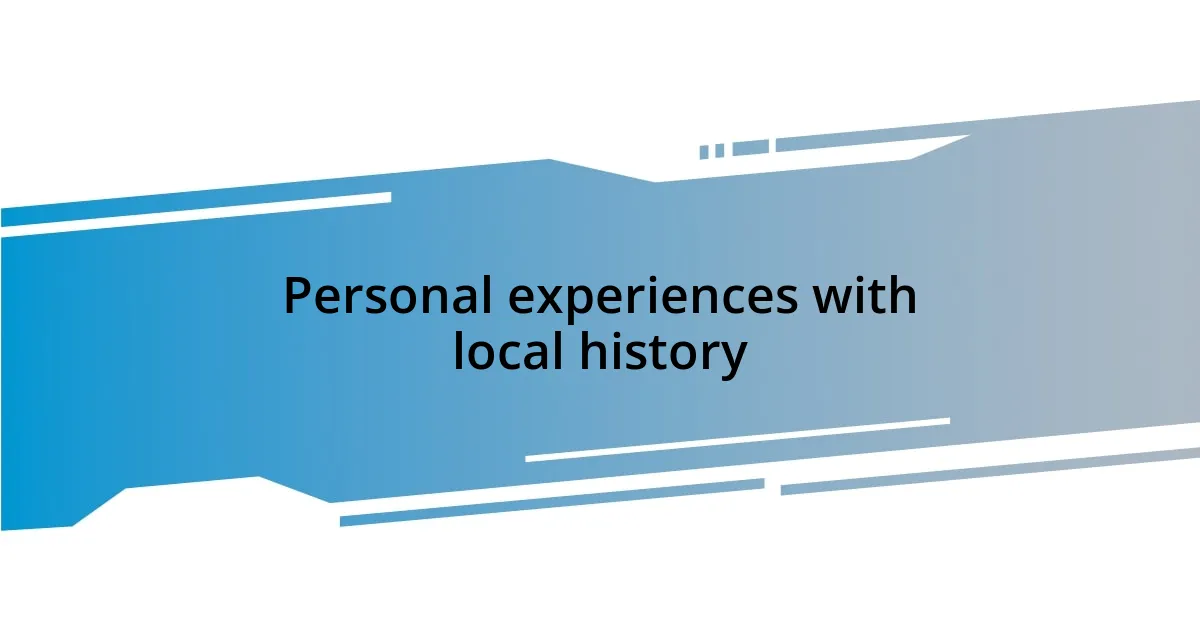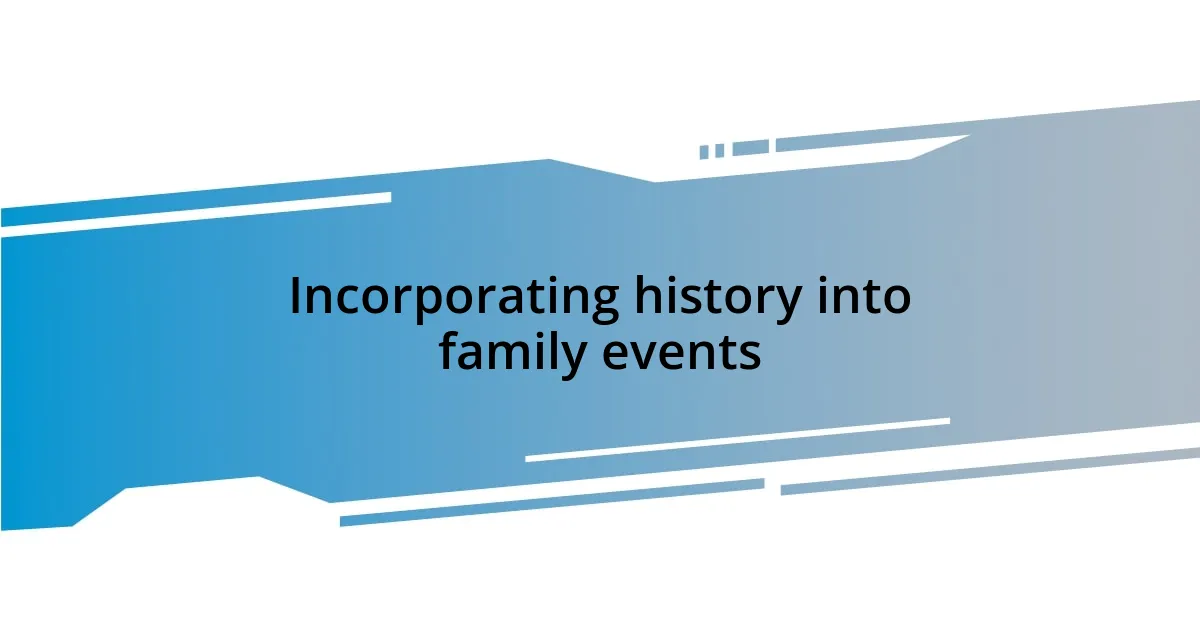Key takeaways:
- Local history is intertwined with personal identity, shaped by family stories and traditions that connect generations.
- Engaging in family traditions and sharing stories fosters a sense of belonging and continuity, enriching emotional experiences.
- Incorporating historical elements into family events deepens appreciation for heritage and creates memorable connections.
- Creating a family tradition guide encourages collaboration and preserves unique customs and stories for future generations.

Understanding local history
Understanding local history goes beyond dates and events; it’s about the stories that shaped our communities. I remember sitting at my grandmother’s table, listening to her recount tales of our town’s founding families. She passionately described how her own ancestors arrived, their struggles and triumphs echoing through the generations. Isn’t it fascinating how these narratives connect us to the very land we stand on?
When I think about local history, I often reflect on how it influences our identities. It’s like an intricate tapestry woven with the threads of countless lives. I had a moment of realization during a local heritage festival, watching families proudly showcase their traditions. It struck me how these customs are not just relics of the past; they’re vital links to our community’s ongoing story. Don’t you find it reassuring to know that, through our traditions, we carry forward the legacies of those who came before us?
Local history provides a lens through which we can understand our present. Each neighborhood, building, and landmark has a narrative that can enrich our lives. I still vividly remember the day we explored an old homestead and discovered forgotten artifacts from a bygone era. The excitement of uncovering these pieces of history felt like rediscovering a piece of my own identity. What treasures might your own community be hiding?

Importance of family traditions
Family traditions serve as the bedrock of our identities, tying us to our past and forming connections across generations. I remember the feeling of anticipation every year as my family prepared for our annual potluck, where each dish told a story. My aunt would proudly bring her grandmother’s famous casserole, each bite a delicious reminder of shared history and culture. In this way, traditions don’t just preserve memories; they actively nurture a sense of belonging.
- They provide a sense of continuity and stability, especially during times of change.
- Family traditions can foster deeper relationships, strengthening bonds through shared experiences.
- They often encourage storytelling, helping pass down important lessons and values.
- Engaging in rituals can evoke feelings of nostalgia and joy, enriching our emotional landscape.
- These customs can spark curiosity about family history, prompting a desire to learn more about our roots.

Personal experiences with local history
Experiencing local history can feel like taking a deep breath and stepping into the shoes of those who came before us. I recall a summer afternoon spent at the local historical society, engrossed in photographs and letters from a century ago. These artifacts whispered secrets about my town’s past—who lived there, and the challenges they faced. It made me realize how interconnected our lives are, transcending time and space. It’s intriguing, isn’t it, to think that we walk the same streets as our ancestors?
In my own family, attending local reenactments has become a cherished tradition. One year, my siblings and I participated in a reenactment of a famous local battle. Dressed in period-appropriate clothing, I felt a visceral connection to those who fought. The air was thick with the tension of the moment, and I could almost hear echoes of history in the background. That day illuminated not only what we were learning but also the emotions tied to those events. Have you ever felt such a bond with the past that it sparks a deeper appreciation for the present?
As I explore local history through family gatherings, I realize that every shared meal carries a story. During last Thanksgiving, my mom shared tales of her childhood in a nearby town, where her family had deep roots. Listening to her, I was transported to a different time and place, each recipe a portal into our family’s narrative. These moments anchor me, enriching my understanding of who we are and where we come from. Isn’t it profound how each anecdote adds another layer to our identity?
| Experience | Emotion |
|---|---|
| Summer afternoon at the historical society | Intrigued by the connection to my town’s past |
| Participating in a local reenactment | Feeling a visceral bond with history |
| Storytelling during family gatherings | Deep appreciation for family identity |

Ways to connect with ancestors
One of the most meaningful ways I’ve connected with my ancestors is through genealogy research. I remember the exhilaration of stumbling upon an old census record, unveiling names and stories I had never known. Each discovery felt like unearthing a piece of a larger puzzle, deepening my appreciation for where I came from. Have you ever traced back your roots? It can be a fascinating journey that reveals both challenges and victories within your family history.
Storytelling is another powerful tool for connecting with our ancestors. At family gatherings, I often find myself sitting down with my grandmother, captivated as she recounts her youth during the Great Depression. Her tales, rich with emotion, remind me not only of her resilience but also of the values and traditions that have shaped our family. Listening to these narratives can evoke a profound sense of pride. How has storytelling enriched your understanding of your own background?
Engaging in cultural practices that my ancestors cherished has also been instrumental in fostering a connection. I recall the first time I tried my hand at making traditional family recipes. The aroma filled my kitchen and transported me to my mother’s kitchen as a child. With each stir of the pot, I felt a sense of continuity, linking me to generations of shared experiences and love. Isn’t it amazing how food can bridge the gap between past and present?

Incorporating history into family events
Incorporating history into family events can transform ordinary gatherings into rich, memorable experiences. I vividly remember hosting a themed family night, where each member brought an artifact or story from our family’s past. It was enlightening to see my cousin’s eyes light up as he shared our great-grandfather’s old compass—a tiny object full of adventures and mysteries that sparked conversations about exploration and resilience. Have you ever noticed how a single item can ignite a flurry of emotions and stories?
Another enriching approach is celebrating historical milestones, which I found brings our family closer together. For my grandmother’s 80th birthday, we created a timeline of her life, highlighting significant events and achievements throughout the decades. Each moment we revisited not only honored her journey but also connected her experiences with the broader context of history. It fascinated me to see how her personal narrative intertwined with world events. Reflecting on our shared history can really deepen our appreciation for our family legacy, don’t you think?
Lastly, integrating local historical landmarks into family outings offers a delightful way to learn together. One Sunday, we embarked on a hike to a nearby civil war-era fort. Standing on the very ground where soldiers once strategized, I felt a palpable sense of respect for those who came before us. My children asked countless questions, and as we explored together, their curiosity made me realize how these experiences cultivate a shared understanding of our heritage. Isn’t it incredible how history can come alive in such unexpected moments?

Sharing stories with future generations
Sharing stories with future generations is a beautiful way to keep our family’s spirit alive. I remember one evening, sitting around the fire pit with my kids, when I decided to share a story about my great-aunt who immigrated to this country with nothing but a suitcase and a determination to succeed. As I watched their eyes widen with intrigue, I realized that these tales not only hold lessons but also form a bridge connecting our past with their future. What are the stories from your family that you share with your loved ones?
When my son got curious about our family name’s origins, I dug deeper than I ever had before. I told him how our surname traces back to a small village in Europe, tied to a rich heritage of artisans and builders. Sharing that personal connection filled him with pride, and it encouraged him to ask more about his own identity. Isn’t it wonderful how one story can spark a myriad of questions and a thirst for knowledge?
I believe that sharing these narratives helps shape not only who we are as individuals but also fosters a sense of belonging. One rainy afternoon, my daughter and I pulled out the old photo albums, flipping through pictures of ancestors we never met, but whom we felt we knew intimately through shared stories. With each turned page, I saw her face light up, and I could feel her excitement mingling with a profound sense of connection. How often do we take the time to reflect on our roots and appreciate how they influence our present?

Creating a family tradition guide
Creating a family tradition guide is all about finding meaningful ways to intertwine history with our present lives. During a family reunion, we decided to compile a “Traditions Book” that captured all the unique customs and stories passed down through generations. Each relative contributed a page, and I can’t tell you how much joy it brought when my uncle recounted the tale of our family bake-offs. You know, those delicious moments spent in the kitchen where the smell of freshly baked pies filled the air and laughter echoed around the table. Isn’t it amazing how a simple recipe can tell such a vibrant story?
To make this guide truly engaging, I’ve found that incorporating photos adds an extra layer of connection. I vividly recall going through old family albums with my children. As we sifted through images of past gatherings, we picked out our favorites to accompany the stories we shared. Seeing their laughter while holding a picture of a great-grandparent’s quirky hat made me realize that visuals enhance our storytelling. They transform history from mere words into a colorful tapestry of experiences, don’t you think?
Lastly, it’s crucial to involve the whole family in the process. When we sat down to create our family tradition guide, I encouraged everyone to share their thoughts and ideas. I was amazed by the diversity of traditions we uncovered, from unique holiday recipes to quirky rituals that my in-laws used to have. This collaborative effort not only made the project richer but also deepened our conversations about what makes our family unique. What traditions do you think your family could add to a guide?
















